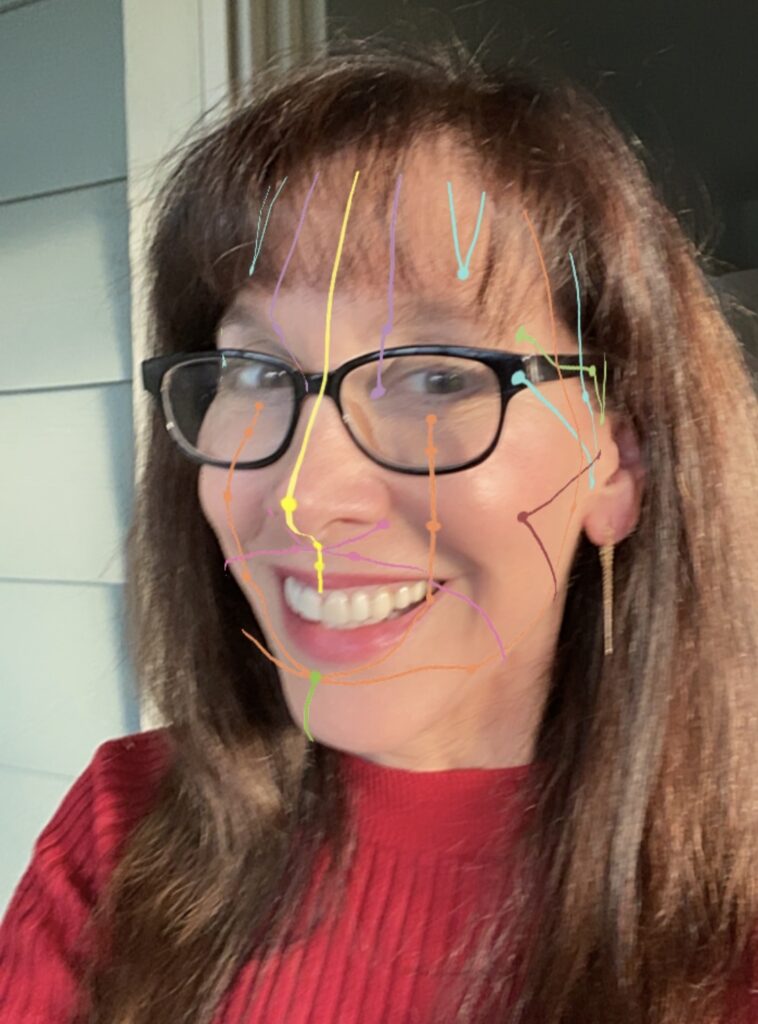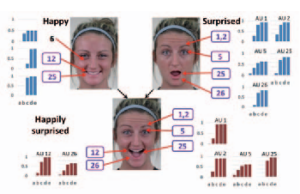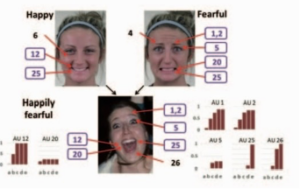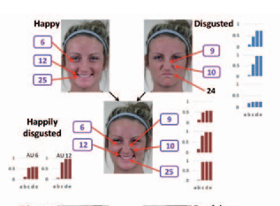By Michelle Gellis AP LAc MAc DiplAc
The anatomy of expression refers to the relationship between our facial expressions, our muscles, meridians and our inner universe. Our face is unique in its ability to radiate shen, display our emotions, desires, intentions, and provide a window into our overall health. As acupuncturists, we have the skills necessary to use the face as a tool to diagnose and treat underlying conditions which may ultimately lead to disease.
Seven Universal Emotions & Facial Expressions.
In the late 1800s, Charles Darwin suggested that facial expressions of emotion are the same wherever you go in the world. In the late 20th century Dr. Paul Ekman traveled the world to research the universality of facial expressions and proved Charles Darwin’s theory was indeed correct. It is now widely supported within the scientific community that there are seven basic emotions, each with their own unique and distinctive facial expressions. They are: Happiness, Sadness, Fear, Disgust, Anger, Contempt & Surprise.1 In addition to the seven basic emotions, there are 15 combination expressions they are:
Happy, Sad, Fearful, Angry, Surprised, Disgusted, Happily Surprised, Happily Disgusted, Sadly Fearful, Sadly Angry, Sadly Surprised, Sadly Disgusted, Fearfully Angry, Fearfully Surprised, Fearfully Disgusted, Angrily Surprised, Angrily Disgusted, Disgustedly Surprised, Appalled, Hatred, Awed.2,3
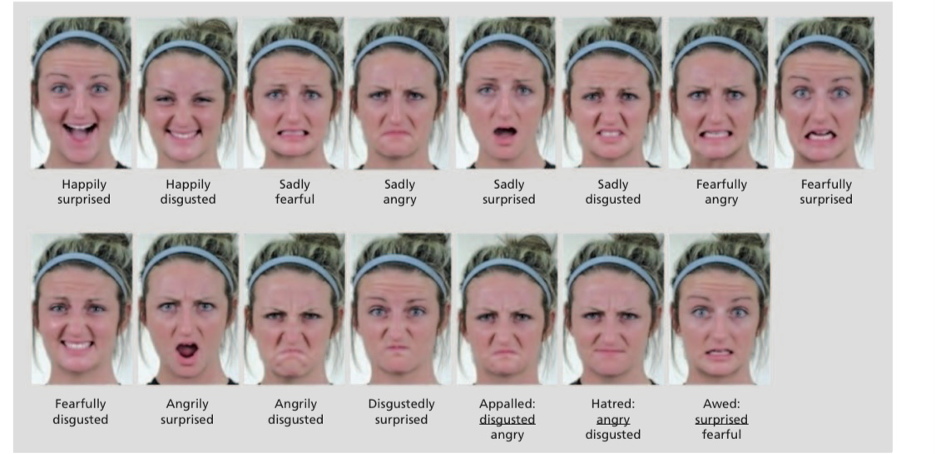
According to 5 element acupuncture principles, an individual’s overall health can be diagnosed through their color sound odor, and emotion. Color can be diagnosed by looking at the face, sound by the voice, odor by smelling the nape of the neck, and emotion can be understood through expression.
Chinese medicine and emotions. Looking at the Five Element correspondences provides insight into the relationship between emotions, organs, and facial expressions.
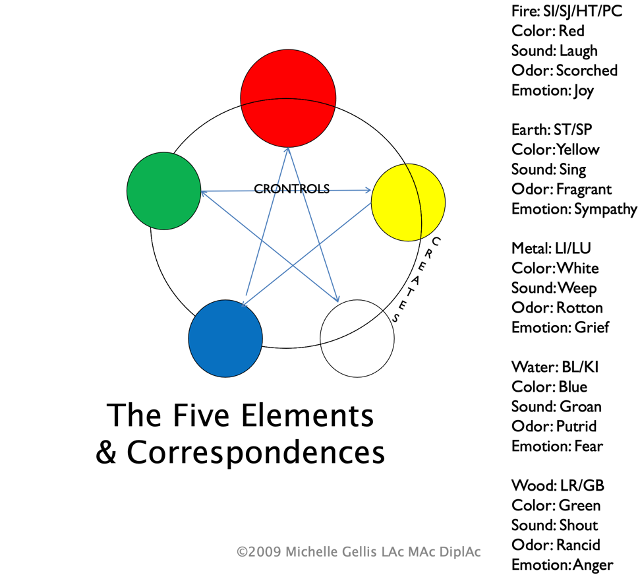
- Anger-LR/GB
- Fear-KI/BL
- Sympathy-disgust-SP/ST
- Joy-Happiness-HT/SI/TE/PC
- Grief-LU/LI
- Fright-(surprise)-KI/BL
Looking at the emotions, we can see their effect on Qi:
- Grief and melancholy consume qi
- Fear causes qi to descend
- Fright disperses the qi
- Anger causes qi to rise and causes qi stagnation
- Joy slows qi
- Worry causes qi stagnation
‘The organs are portrayed in terms of their mental, emotional and spiritual functions. When emotions are prolonged, intense, or unexpressed, they inhibit the normal flow of Qi’- Su Wen Chapter
Feedback system between face and organs. There is a feedback system between the face, emotions, and internal organs. This system is intrinsic to the appearance of the face and health of the internal organs. Studies have demonstrated if a person merely arranges their face into a certain expression, they will feel the corresponding emotion.4 Emotions work from the outside in, as well as the inside out – i.e. happiness may be as simple as ‘putting on a smile’.
An individual who cannot or does not express emotions through their facial expressions will not feel the emotion as fully. An experiment involving the use of Botoxtm to paralyze the facial muscles involved in frowning identified a decrease of depressive symptoms in patients. This demonstrated that facial feedback modulates the neural processing of emotions.5,6
Habitual patterns of expression get lodged in the face. The associated repressed or excessive emotions affect our organs. It is a two-way system with feedback from the face to the internal organs and vice versa. There must be a free flow of emotions to and from the face, hence, facial acupuncture can play an important role in promoting health. Any impediment to qi and blood flow in the points and channels of the face will translate to diminished function – both physical and emotional. Treating the acupuncture points responsible for specific muscle movements can create ease in the patient by opening up the pathways and return the muscle to a more normal level of functioning.
Obstruction of Qi. One of the most common causes of disease is the obstruction of the flow of qi (energetic blocks) caused by unexpressed emotions. Emotions aren’t a problem in and of themselves, it is our relation to the emotion that can cause our Qi to become blocked. In health, we feel emotions in the appropriate context and do not unconsciously react to the presence of that emotion in ourselves or in another. When we become triggered and have an unconscious learned habitual response that is where the problem lies. Our job as practitioners is to create awareness within our patients of these habitual responses.
Diagnosis: In order to determine which muscles are being used and require treatment, we can turn to Action Units. Action Units (AU) are the fundamental actions of individual muscles or groups of muscles. The Facial Action Coding System (FACS) is a system to taxonomize human facial movements by their appearance on the face, based on a system originally developed by a Swedish anatomist named Carl-Herman Hjortst. It was later adopted by Paul Ekman and Wallace V. Friesen, and published in 1978.10
Categorizing Facial expressions.
- Action Units (AUs) An AU is a set of facial muscle articulations that results in a unique visible image feature. For example, when the frontalis muscle contracts, there is a visible rising of the inner section of the eyebrows, and this is denoted AU 1.
- AU6 DRAWS SKIN TOWARDS THE EYE FROM THE TEMPLE AND CHEEKS. AS THE ORBITAL PORTION OF THE O. MUSCLE CONSTRICTS IT:7

AU6 action unit of eyes a – NARROWS THE EYE APERTURE b – BAGS OR WRINKLES THE SKIN BELOW THE EYE c – PUSHES THE EYE COVER FOLD DOWN d – RAISES THE CHEEK UPWARD e – POTENTIALLY CAUSES CROW’S FEET “LAUGH LINES” OR WRINKLES


Facial Action Coding System (FACS) is a system to classify human facial movements by their appearance on the face for example, when smiling, you would utilize the cheek raiser muscles which involve AU6, AU12(LIP CORNER PULLER ), AU25(Lips part)7
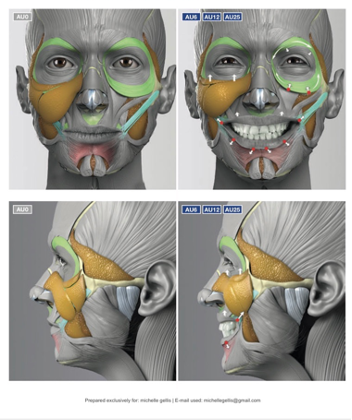
For example:
In order to treat expression lines involved in smiling you would treat:
Orbicularis Oculi: GB1, BL2, ST2, QUI HOU, Jiangming, TE 23, YUYAO, needled upwards
Orbicularis Oris: Two motor points: LI19, Located 1/2way between ST4 and REN24
Zygomaticus Major: SI 18
Depressor Labii Inferioris: jiachengjiang
Used with permission-Anatomy of Expression7
Action units can also be used to diagnose and treat complex expression of emotion such as: Happily Surprised-Happily Fearful-Happy Disgusted 3
From Compound facial expressions of emotion. Shichuan Du, Yong Tao, and Aleix M. Martinez
For each of the other basic emotions, the diagnosis and treatment methods are designed based on using the different AUs involved.
Treating the acupuncture point. One method of treatment is by directly addressing the points on the muscles responsible for specific muscle movements. This can create ease in the patient by opening up the pathways and return the muscle to a more normal level of functioning. Treating the acupuncture points in the muscles which are overused and have become tense or attenuated can return to their normal functioning.
Treating the channel. Besides treating the acupoint in the muscle, one must look at both the correlation of the acupuncture point and its corresponding organ system. If a patient has deep frown lines, which correspond to the expression of anger, treating heat or stagnation in the Liver channel may create ease and relax the forehead. Conversely, treating said points may also relax the liver.
Energetic blocks. In the five-element acupuncture style popularized by J.R. Worsley, a block is defined as ‘a break-in, or impediment to, the smooth flow of Qi.’8 The Ling Shu (Miraculous Pivot) teaches us, ‘Only when the stagnation is cleared away can the channels be vented and Yin and Yang be harmonized.’9 If qi and blood cannot flow smoothly through the points, channels, and muscles of the face, facial treatment will not be as effective and health will be compromised. Blocks are diagnosed in various ways. Some show up on the pulses as a disparity in the strength of one pulse in relation to another or in the strength of the left side pulses to the right (see below). Other blocks manifest primarily in a patient’s physical or psycho-emotional state. In some instances, a patient’s history can be indicative of a potential block, for example, physical injury, emotional trauma and drug or alcohol abuse. Blocks vary in severity and significance. Some are dire and require immediate attention, while others are less severe and merely resurface from time to time to cause troublesome symptoms. The list of blocks below shows the order of treatment priority if they are present: Possession (internal/external demons), Aggressive Energy, Husband-Wife, Entry-Exit (E/E). In this article I will only briefly discuss Entry-Exit blocks, as they directly relate to the face. For a more detailed explanation of this and other blocks, please visit my class ‘The Anatomy of Expression’ and see my article, ‘the importance of clearing blocks prior to facial acupuncture treatment’4. For detailed information on the diagnosis and treatment of the other blocks please refer to The Clinical Practice of Chinese Medicine.11
In Su Wen Chapter 8 the organs are portrayed in terms of their mental, emotional and spiritual functions. When emotions are prolonged, intense, or unexpressed, they inhibit the normal flow of qi. As mentioned, one of the most common causes of disease is the obstruction of the flow of qi caused by unexpressed emotions. Any energetic blocks which may be occurring to inhibit the proper functioning of the muscle and smooth flow of qi throughout the channel. Repetitive or repressed expressions can not only affect a person’s appearance but can affect the associated organ system. In the following case, the fire and wood officials.
For example, if during diagnosis a practitioner assessed an entry-exit block on the pulse that pointed to a block between TH ad GB (TH pulse larger than GB) the practitioner should look at both the local indications such as temporal headaches, or ringing in the ears and the spirit of the points (see below), then assess what the underlying root cause of the condition is.
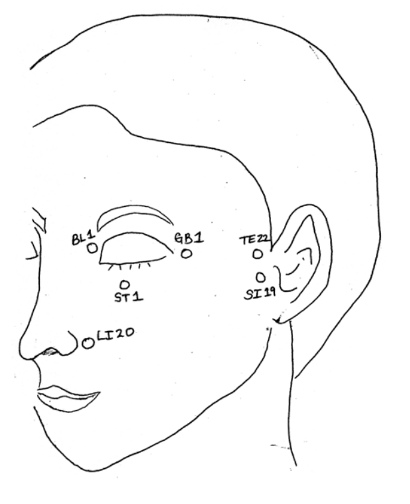
Treatment for VI/VII (TH/GB) block
To treat this block the practitioner would:
- Tonify* the exit point of the lower-numbered meridian (stronger pulse) (TE)
- Then tonify* the entry point of the next meridian(GB)
- This is done bilaterally
- Remove, seal
*Tonify=insert needle, turn 180 degrees clockwise
Below is an example of the spirit of the points a practitioner might use depending on the patient’s presentation. This is taken directly from my live and recorded classes “The Anatomy of Expression”12 and “Facial Acupuncture Certification”12
Spirit of the points:
Entry/Exit on face
SJ22– Erheliao- Harmony Bone- exit on San Jiao-harmonizes GB, SI, and TH. Useful for a patient driven to pursue inappropriate connection in an attempt to experience intimacy or warmth.
GB1-Tong zi liao-entry on GB-orbit bone-helps to drain heat due to our mental and emotional frustration. Hard to make decisions when one has pain, or difficulty seeing. this point can be used to promote clarity and vision at all levels of BMS.
Body points:
GB41-Foot Above Tears
-Allows for emotional release of frustration/anger.
-Grounds the patient.
-Spreads stagnant Qi in Liver and GB channel
TE17-Wind Screen
-Empowers us to be less susceptible to other people’s opinions about us11
-Activates the channel,
-Alleviates wind, clears heat.
-Local point for lifting the face.
The order of treatment would be to first clear blocks and then treat any local face points and or spirit points. Facial cupping and Gua Sha can also be an effective tool in releasing the tense muscles and Improving blood and qi flow to under or overused muscles.
In conclusion, the face can be a useful diagnostic tool for diagnosis and treatment planning. Our entire history lives in our face and it etched in our facial expressions. Relaxing and tonifying muscles, treating the spirit, and clearing energetic blocks can bring forth universal emotional, spiritual, and energetic shifts in our patients.
1https://www.eiagroup.com/facial-expressions-explored/
2https://www.pnas.org/content/111/15/E1454
3https://news.osu.edu/computer-maps-21-distinct-emotional-expressions–even-happily-disgusted/
4 https://facialacupunctureclasses.com/wp-content/uploads/2019/02/The-Importance-of-Clearing-Blocks-Prior-to-Facial-Acupuncture-Treatment1.pdf
5Klasen, M., Kreifelts, B., Chen, Y. et al. (2014). Neural processing of emotion in multimodal settings, Frontiers in Human Neuroscience, 8:822, doi: 10.3389/ fnhum.2014.00822
6Hennenlotter, A., Dresel, C., Castrop, F. et al. (2009). The link between facial feedback and neural activity within central circuitries of emotion–new insights from botulinum toxin induced denervation of frown muscles, Cereb Cortex, 19(3), pp. 537-42
7 Zarins, Uldis. (2017) Anatomy of Facial Expressions. Anatomy Next, Inc., New York.
8 Smith, S.M. (1998). The Five Element Acupuncture Handbook. S.M. Smith: Columbia, p.147
9 Veith, I. (1972). The Yellow Emperor’s Classic of Internal Medicine. University of California Press: Oakland, p.260
10 https://www.paulekman.com/wp-content/uploads/2013/07/Facial-Sign-Of-Emotional-Experience.pdf
11Jarrett, L.S. (2003). The Clinical Practice of Chinese Medicine. Spirit Path Press: Richmond
12 https://www.facialacupunctureclasses.com

